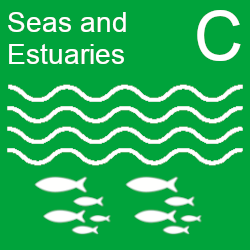Notice: From 01 December 2025, the Outcome Indicator Framework dashboard has been moved. Future updates to this publication are available on GOV.UK at: Environmental Indicator Framework.
Short Description
This indicator tracks changes in the occurrence of sensitive fish species at risk of depletion. The indicator is derived from individual assessments of populations based on scientific survey data; note that a subset of species may also be included in indicator C6 Diverse seas: status of threatened and declining features. The indicator is linked to the UK Marine Strategy Descriptor 1 (biodiversity) and the Convention for the Protection of the Marine Environment of the North-East Atlantic (OSPAR).
Readiness and links to data
Data on the occurrence of sensitive fish species are drawn from OSPAR common indicator ‘Recovery of Sensitive Fish Species’, produced as part of the OSPAR Quality Status Report (QSR) 2023.
Notes on indicator
Species are assessed for evidence of a significant increase or decrease in frequency of occurrence across the assessment period (2015 to 2020) compared to a reference period, and results of these assessments are presented here. There is an aspiration to reverse any long-term depletion of species populations, so the basis of the assessment is a long-term reference period inclusive of all years prior to the assessment period for which there are robust survey data (that is, 1983 to 2014). To identify whether depletion is ongoing or if signs of recovery are evident, a secondary short-term reference period is also defined (here, 2009 to 2014).
Indicator components
Figure C11: Long-term and short-term changes in the occurrence of sensitive fish species, Greater North Sea and Celtic Seas, 1983 to 2020
Table C11: Long-term and short-term changes in the occurrence of sensitive fish species, Greater North Sea and Celtic Seas, 1983 to 2020
| Ospar region | Time period | Declining | Mixed | Stable | Recovering |
|---|---|---|---|---|---|
| Celtic Seas | Long term (1983-2014 to 2015-2020) | 15.38 | 11.54 | 26.92 | 46.15 |
| Celtic Seas | Short term (2009-2014 to 2015-2020) | 18.52 | 3.70 | 33.33 | 44.44 |
| Greater North Sea | Long term (1983-2014 to 2015-2020) | 15.15 | 6.06 | 36.36 | 42.42 |
| Greater North Sea | Short term (2009-2014 to 2015-2020) | 12.12 | - | 39.39 | 48.48 |
Trend description for C11
In the Celtic Seas, over the long term, 12 (46%) of the 26 species assessed are recovering, while 4 (15%) of the 26 species assessed show a significant decline in occurrence, over the assessment period (2015 to 2020) compared to the long-term reference period (1983 to 2014).
In the Celtic Seas, over the short term, 12 (44%) of the 27 species assessed are recovering, while 5 (19%) of the 27 species assessed show a significant decline in occurrence, over the assessment period (2015 to 2020) compared to the short-term reference period (2009 to 2014).
In the Greater North Sea, over the long term, 14 (42%) of the 33 species assessed are recovering, while 5 (15%) of the 33 species assessed show a significant decline in occurrence, over the assessment period (2015 to 2020) compared to the long-term reference period (1983 to 2014).
In the Greater North Sea, over the short term, 16 (48%) of the 33 species assessed are recovering, while 4 (12%) of the 33 species assessed show a significant decline in the assessment period (2015 to 2020) compared to the short-term reference period (2009 to 2014).
Assessment of change
No assessment of change was undertaken for this indicator as a suitable time series is not yet available in the Outcome Indicator Framework.

